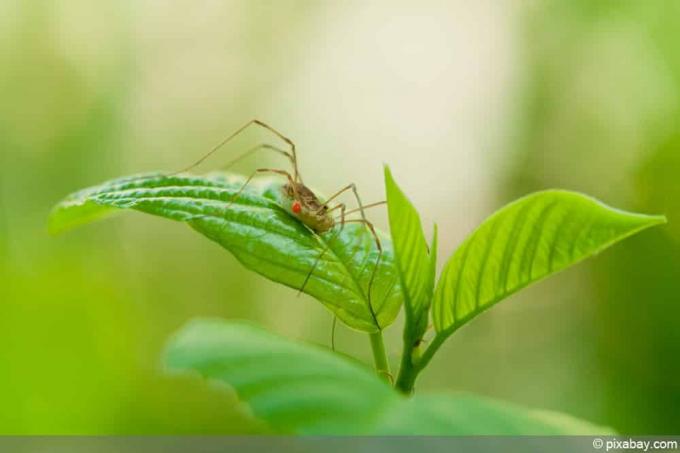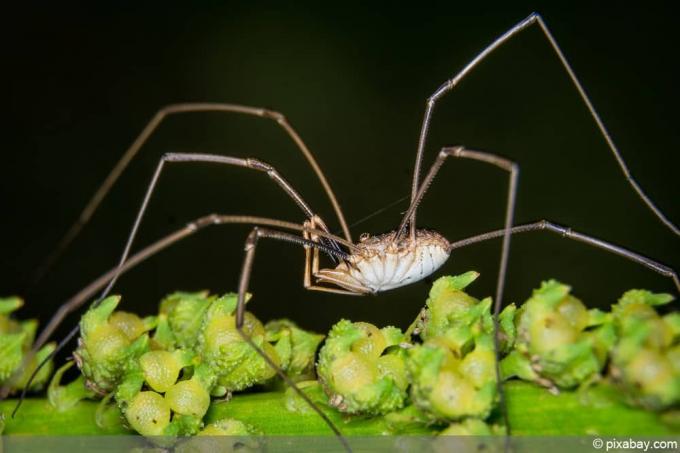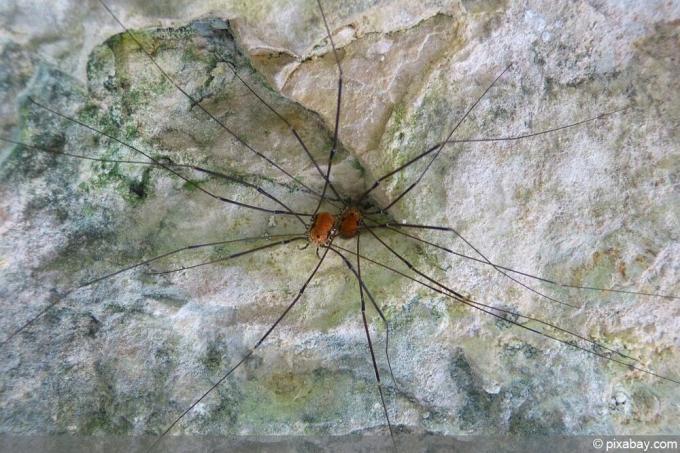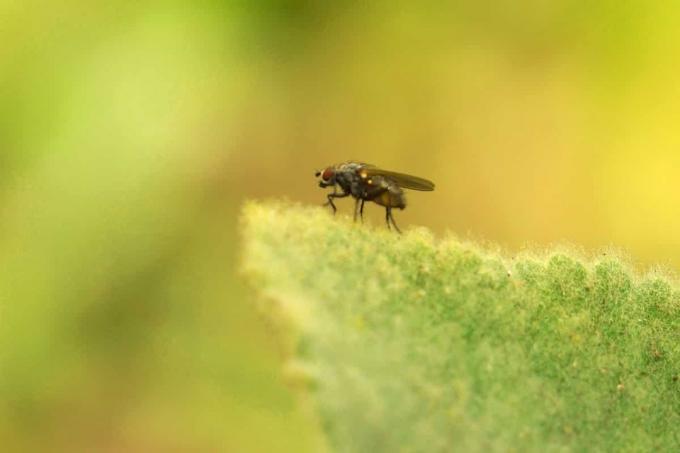

Table of contents
- One arachnid, many names
- This arachnid is not a spider
- Recognize a shoemaker by the aisle
- Are harvestman spiders poisonous?
- The tailors' favorite dishes
- The ancestral habitats
- Harvester as a roommate
- How to get rid of the harvestman spider
- How to keep the harvestman spider away
- Drive away cobblers with lavender
- Chemicals against harvestman spiders
- Where are the offspring lurking?
There is hardly a place on planet earth where arachnids do not crawl. Some species are also native to this country, such as the harvestman spider. She scurries around quickly on her long legs and even shows up in our rooms. Again and again she reaped screams of horror. Admittedly, she is not suitable as a pet, but is she also dangerous?
One arachnid, many names
If the harvestman spider doesn't tell you anything, then it could just be the unknown name. This creature has several of them, depending on the area in which it is spoken of. Perhaps you know this crawling animal as a shoemaker or tailor. In some places it also has somewhat strange names such as Grandpa Long Legs or Kanker. The Swiss simply call this arachnid Zimmermann, the scientific name for harvestmen is Opiliones. Many of those names may be unfamiliar, but this arachnid certainly isn't. Everyone gets to see harvestmen from time to time, precisely because they also like to stay in our rooms.
This arachnid is not a spider
The harvestmen belong to the arachnids, just like the "real" spiders. But harvestmen are not spiders, even if their appearance strongly suggests so. They only look confusingly similar to spiders. Only those who take a closer look can notice the subtle differences. How to recognize harvestmen:
- have eight legs, like all arachnids
- Legs are usually very long
- every walking leg has many joints
- two tactile organs are located in the mouth area
- Tactile organs look like shorter legs
- only have two eyes (spiders usually have eight)
- uniform, oval body (spider body consists of two parts)
- Body color can vary by species but is most commonly gray or brown
- some species have a clearly patterned back
- are out and about at dusk or at night
- have no web glands
- consequently they do not spin webs
A notice:
A little more than 100 species of harvestman spider live in Central Europe. They may well differ in appearance in some features.
Recognize a shoemaker by the aisle

Thin, long legs are typical of shoemakers. They have a lot of joints and are therefore extremely flexible. They give the harvestmen a gait that makes them easy to spot. They feel their surroundings with their legs while walking. They are good climbers and are often spotted outdoors on shrubs. They can wrap each leg around blades of grass, twigs or leaves as they wish, as if it were a lasso. Secured in this way, they move skillfully from one plant to another, even if the passage seems a bit wobbly.
A notice:
Some harvestmen's legs can be 20 times longer than their torso. Why they need long legs has not yet been scientifically clarified.
Are harvestman spiders poisonous?
Harvester spiders do not have venom glands like venomous spiders. However, they can make similar secretions in their stink glands. The fetid discharge is for their own protection. This allows them to deter attackers and fend them off successfully. The species living in this country do not pose any danger to humans, as they cannot bite poisonously. Not only do they not pose a life-threatening threat, they cannot cause us any other pain.
The tailors' favorite dishes
Harvestmen feed on tiny parts of plants. They use their jawed claws to search the immediate area for them. Dead small animals are also part of their diet. They also catch small arthropods, which they eat alive. However, the captured arthropods are microscopic. Harvestmen can be described as omnivores because they do not disdain either plant or animal food. But they also have natural predators in the wild: birds, frogs, bats, fire salamanders and spiders. They are safe from most of these enemies indoors. Except for spiders, these are extremely rare to find in a house.
A notice:
Did you know that when harvestmen are attacked, they just drop a leg? You leave it to the enemy and can escape that way. However, the lost leg does not grow back.
The ancestral habitats
Most harvestmen live outside in the great outdoors. They can be found on meadows, trees and bushes. They can also be found as ground dwellers. Some of them live on house walls or invade people's living quarters. If left alone, they will take full advantage of the environment as a habitat. They can be found in large numbers in abandoned houses, rarely entered cellars or overgrown gardens. But even in a well-kept garden, they can never be completely kept away. From there you can easily find your way into the inhabited house.
Harvester as a roommate

When a harvestman spider enters and lives in a home, it is rarely welcome. Not only people with a spider phobia have an aversion to this roommate, nobody else wants to tolerate them in their own four walls either. It isn't dangerous and doesn't spin any annoying webs, but who knows where it might go unnoticed. It may crawl over your face or even into your mouth at night while you're dreaming unsuspectingly. As soon as such an animal is sighted, everything is done immediately to get rid of it quickly before it can crawl away. The "hit" method is often used, as it promises success. But that doesn't have to be the case, because the harvestmen are otherwise useful animals. Some species are even endangered.
How to get rid of the harvestman spider
Many people do not want to get too close to the harvestman spider. That's why they come with the vacuum cleaner. The strong suction force is intended to destroy the slender spider body without leaving residue on the walls. But the delicate body only looks fragile, in reality it is surprisingly resilient and usually survives this procedure. If the vacuum cleaner bag is not taken out of the house immediately and disposed of safely, the cobbler will be out again in no time. Instead of trying to kill the harvestman spider in some other way, it is better to remove it alive from the house. To do this, you simply grab her by one leg and carry her out. If you don't want to touch them, you can put a container over them and then slide a sheet underneath. Now she can be taken out and released there.
Tip:
During the day, the nocturnal harvestmen hide in their shelters. So if you want to specifically search their dwelling for them, you should do it after dusk.
How to keep the harvestman spider away
Whenever you discover a harvestman spider in your house, you can laboriously catch and carry it out. A copy will probably appear again in the foreseeable future. If you don't want to keep fighting these arachnids, it's a good idea to keep them out of your home altogether. To do this, the harvestman spider's access to the house must be effectively blocked. A fly screen on the windows and doors keeps the annoying long-legged friends outside. Crevices and crevices must be sealed with silicone to prevent them from slipping through side cracks. The service life of fly screens is limited, so they must be replaced at regular intervals of a few years.
Drive away cobblers with lavender
Lavender is another completely natural remedy for these pests. Most people find the scent of lavender extremely pleasant, while cobblers are put off by it. Lavender sachets or lavender oil can be distributed in suitable places. Shoemakers who are already in the house will quickly run away again if they smell this unpleasant smell. Others will not even enter the house.
Chemicals against harvestman spiders

Chemical remedies against these arachnids are commercially available and should therefore also be mentioned here. It remains to be seen whether the funds are actually as effective as the manufacturers promise. Irrespective of this, there are many reasons that speak against the use of chemicals:
- Chemicals can be harmful to humans
- children in particular can be sensitive to it
- it could also be harmful to pets
- Chemistry does not bring a permanent solution
- no mortal danger emanates from the harvestmen
- other “gentle” methods are available
The use of chemicals should always be carefully considered. If so, chemistry should only be used as a last resort.
Where are the offspring lurking?
Once you spot a big cobbler and remove it from the house, the question arises: Are there more of these arachnids hiding somewhere? Or are there even eggs in a hiding place from which more harvestmen will soon hatch? In fact, the offspring of these arachnids grow from eggs.
- after direct fertilization, the female lays eggs
- there are up to 500 eggs at the start
- small holes and crevices in the ground are ideal storage places
- cracks in walls are also suitable
- Young hatch in the fall
- or in the spring of the following year
But don't worry, this is unlikely in an inhabited house. Where there is regular cleaning and every cobbler is consistently removed, there will hardly be two to take care of offspring. Harvestmen also live as loners.
 garden editorial
garden editorial I write about everything that interests me in my garden.
Learn more about home pests

Drive away cockroaches: leave the light on at night?
Cockroaches are among the most disgusting pests that can appear in living spaces. But the disgust factor is only one side of the coin. The other is that the crawlies contaminate food supplies with pathogens. It is therefore essential to declare war on insects. Can cockroaches be repelled by leaving the light on at night?

Spotting mites in bed: 9 signs of bed mites
Mites are found everywhere in the home. Even in a clean, well-groomed bed, millions of animals can be found. This is not only a problem for allergy sufferers, but can also cause allergies.

Identify cockroaches: what do cockroaches look like?
Cockroaches are disgusting, everyone agrees on that. Worse still, they nibble at our food supplies and leave behind disease-causing germs. Because cockroaches flee and hide at lightning speed, we rarely see them. But then everyone should recognize them immediately.

Electric spider in the house: how to get rid of it
A thin body and long, thin legs characterize the electric spider. It got its name because it trembles when touched. The insect likes to stay indoors. Read how to banish the unwanted guest from your apartment.

Caution hantavirus: properly remove mouse droppings
Anyone who lives in the country, maybe keeps animals or who is often out and about in the forest is at risk from so-called hantaviruses. These are transmitted by mice and their droppings, so you should take extra precautions when removing them.

Fight houseflies: 10 remedies & tips
The housefly can be fought with various traps that have been prepared with attractants. Adhesive surfaces or liquids ensure that the insects can no longer escape. In addition, there are simple measures to keep the annoying flies out of the apartment.



